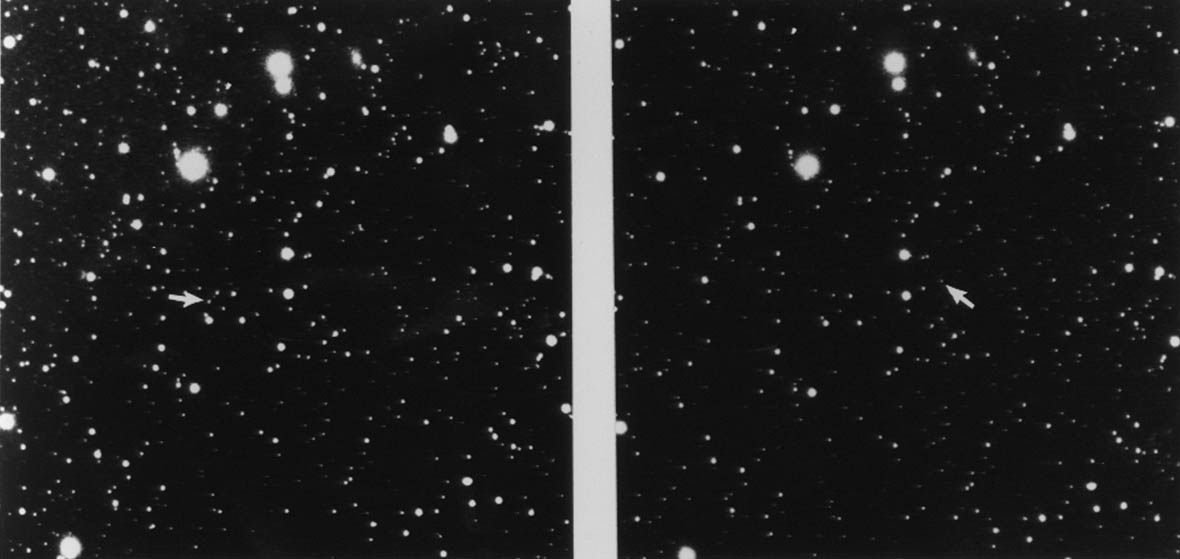
The discovery of the planet Uranus by British astronomer William Herschel in 1781 essentially doubled the size of the then-known solar system. During the years after Uranus’ discovery astronomers began to notice small discrepancies in its orbital motion, and at least two individuals – a young British astronomer named John Adams, and a French mathematician, Urbain Le Verrier – concluded that these might be due to perturbations by an unknown planet orbiting the sun beyond Uranus, and attempted to calculate where in the sky such a planet might be located. Adams’ calculations, which were rather imprecise to begin with, were essentially ignored by astronomers in England, however Le Verrier was able to have his predictions communicated to Johann Galle and Heinrich d’Arrest at the Berlin Observatory in Germany, who in turn found the planet we now call Neptune within an hour of searching and within one degree of Le Verrier’s predicted position.
While Neptune’s discovery seemed to take care of most of the discrepancies in Uranus’ orbital motion, there still seemed to be some minor discrepancies left over, and some astronomers concluded that there might still be another planet beyond Neptune. One such person was the wealthy American amateur astronomer Percival Lowell, who built his namesake observatory near Flagstaff, Arizona in 1894 and who popularized the idea that Mars had been inhabited by a dying civilization and had accordingly built a worldwide network of “canals.” Lowell calculated positions for a so-called “Planet X” and initiated search efforts from Lowell Observatory in 1906 which he continued up until his death ten years later; it turns out that his object did show up on a couple of his search photographs but he didn’t recognize them at the time.
Following a protracted legal battle with Lowell’s widow, Lowell Observatory resumed the search for “Planet X” in 1929 and hired a 23-year-old amateur astronomer from Kansas, Clyde Tombaugh, to conduct the actual search. Tombaugh’s job was to take large-field photographs of regions of the night sky in pairs separated by a few nights, and then to compare these pairs of photographs using a device called a “blink comparator” to search for moving objects. On the afternoon of February 18, 1930, while comparing two photographs taken on January 23 and 29 of that year, he spotted a slow-moving 15th-magnitude stellar object relatively close to the predicted location of Lowell’s “Planet X,” and after verification of the object’s existence and motion over the next couple of weeks, Lowell Observatory announced the discovery on March 13, 1930, the 149th anniversary of Herschel’s discovery of Uranus.
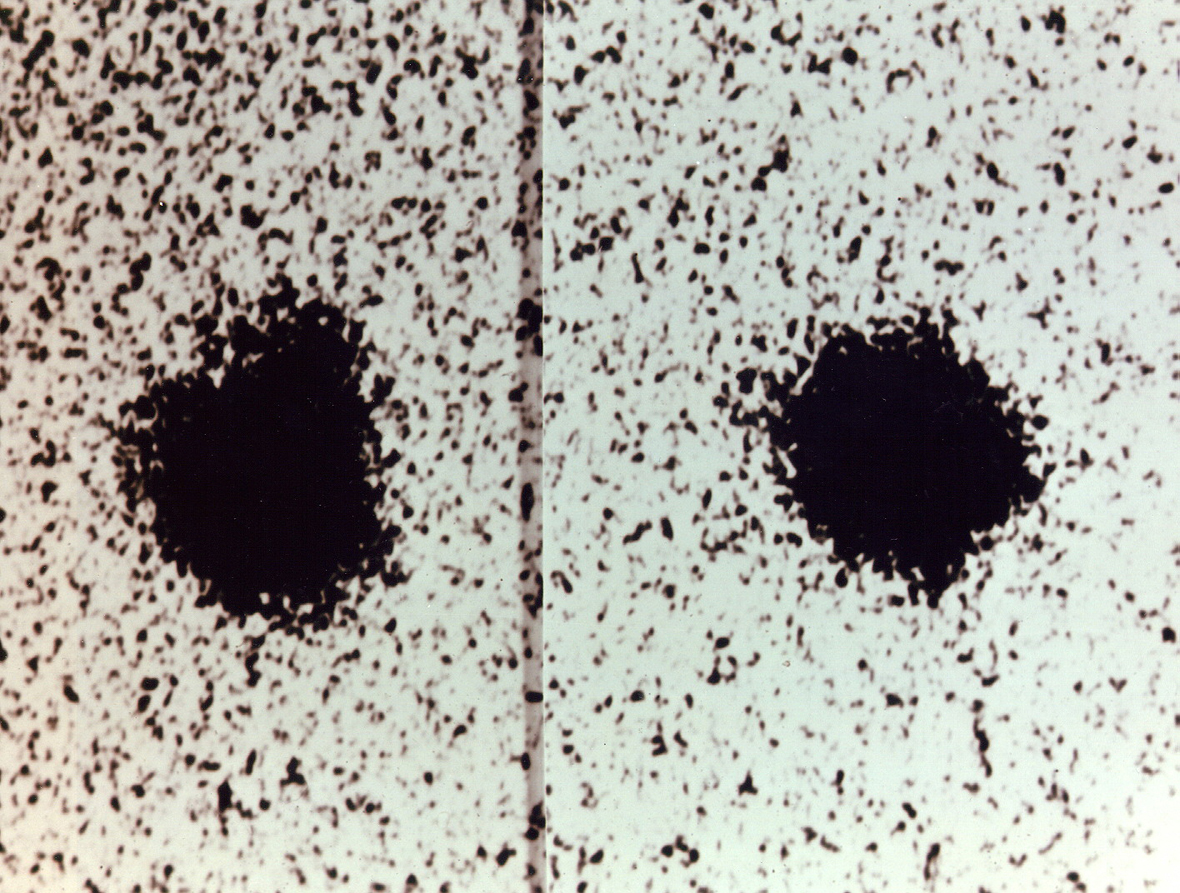
Lowell Observatory received numerous suggestions for a name for the newly-discovered world, but soon settled on “Pluto,” which had been suggested by an 11-year-old schoolgirl from Oxford, England named Venetia Burney. Pluto, the Roman god of the underworld, seemed an appropriate name for a world located in the distant outer reaches of the solar system, and it was not lost on the Lowell staff at the time that the first two letters of the name “Pluto,” i.e., “PL,” are the initials for Percival Lowell.
Being as distant as it is, and as dim as it is, very little information could be gleaned about Pluto for quite some time. Not much could be discerned about its physical nature, although the general assumptions were that it was perhaps approximately the size of Earth. The orbital period has been calculated as being 248 years, with an inclination of 17 degrees, unusually large for a planet. Furthermore, although Pluto’s average distance from the sun is 39.5 AU, it has a distinctly non-circular orbit, with an eccentricity of 0.25; for 20 years of its orbit it is actually closer to the sun than Neptune. Such was the situation between 1979 and 1999, with perihelion passage at a heliocentric distance of 29.66 AU taking place on September 5, 1989. Meanwhile, detailed studies of Pluto’s brightness behavior revealed small periodic brightness variations which suggested a rotational period of 6.4 days.
Continued studies of Pluto over subsequent decades, including a couple of near-miss occultations of background stars, suggested that it is smaller than was originally believed, and estimates of its diameter and mass kept being revised downward. The big breakthrough finally came on June 22, 1978, when U.S. Naval Observatory astronomer James Christy was examining photographs of Pluto that had been taken for astrometric purposes, and noticed that a small “bump” regularly appeared in the images of Pluto but not in the images of surrounding stars. Christy concluded that he had found a moon orbiting Pluto, and with its appearances indicating an orbital period of approximately 6.4 days this in turn suggested that it was in synchronous orbit around Pluto. Christy named this putative moon “Charon,” after the ferryman across the River Styx in Greek mythology.
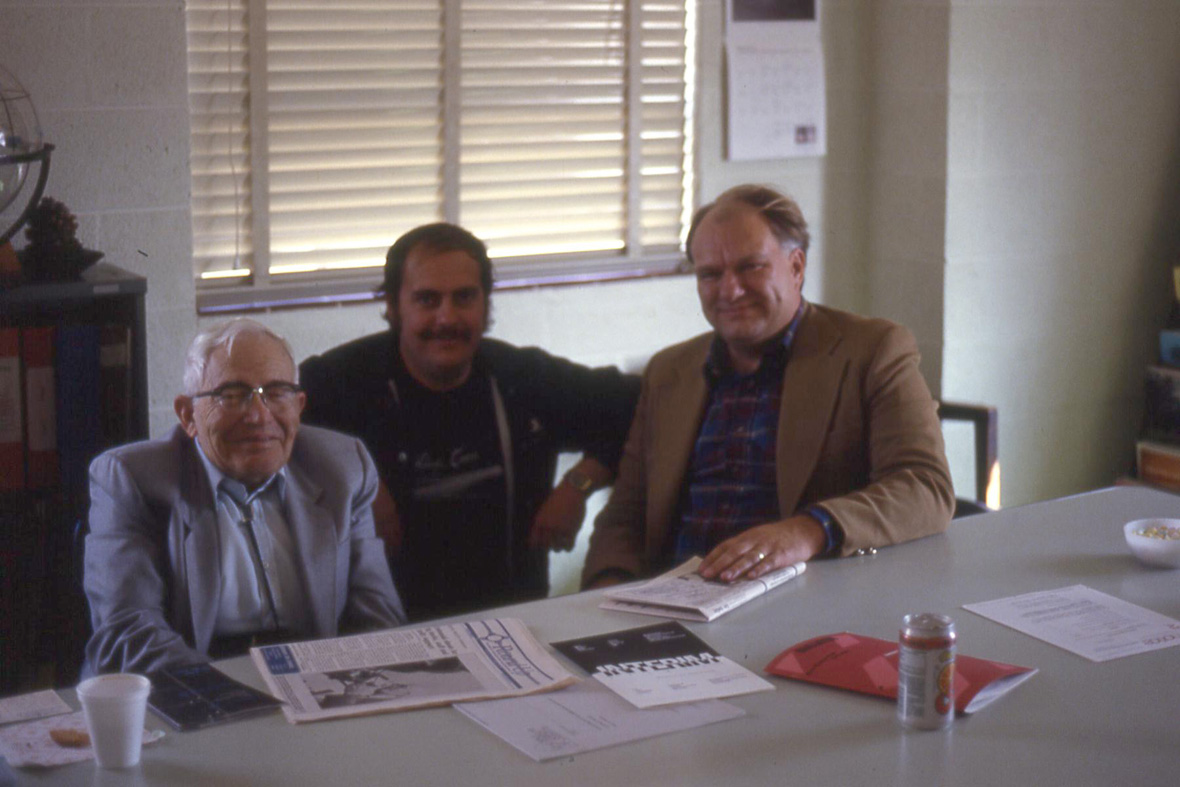
The discovery of Charon allowed a rather precise determination of Pluto’s mass (from Newton’s Law of Universal Gravitation), which has been found to be only 1/6 of the moon’s mass. Furthermore, due to a fortuitous alignment of Charon’s orbit around Pluto with respect to Earth, in early 1985 Pluto and Charon began a series of mutual occultation events – i.e., each object regularly passing in front of and then behind the other – that lasted for the next five years. In addition to allowing final confirmation of Charon’s existence, these events also allowed accurate size measurements to be made of both objects: Pluto’s diameter is slightly under 2400 km (a little over 2/3 of the moon’s diameter), and Charon’s diameter is just over 1200 km – just over 1/3 of the moon’s diameter and almost exactly half of Pluto’s diameter.
In hindsight, Pluto is clearly nowhere near massive enough to have caused any discernible changes in Uranus’ orbit, and the fact that it was discovered fairly close to Percival Lowell’s predicted location for “Planet X” can be nothing more than a coincidence. The Voyager 2 encounter with Neptune in 1989 allowed for a more precise determination of that planet’s mass, and the revised value alone eliminates the minor discrepancies that existed earlier.
On June 9, 1988, Pluto occulted a 12th-magnitude star in the constellation Virgo. Both the star’s disappearance and reappearance were gradual rather than abrupt, thus providing the first direct evidence that Pluto has an atmosphere, albeit a relatively thin one. Studies since then have shown that the atmosphere is primarily made up of nitrogen and smaller amounts of methane and carbon monoxide. Since Pluto was then fairly close to its perihelion passage there has been some speculation that the atmosphere is temporary and is being produced by solar heating – what little there is at such a distance – sublimating its surface materials. Since the atmosphere is still persisting today, three decades beyond Pluto’s perihelion – as revealed by Pluto’s occultation of a 13th magnitude star in August 2018 – the situation is apparently more complex than that, and it will likely be another few decades – as Pluto continues to recede from perihelion – before this can be sorted out.
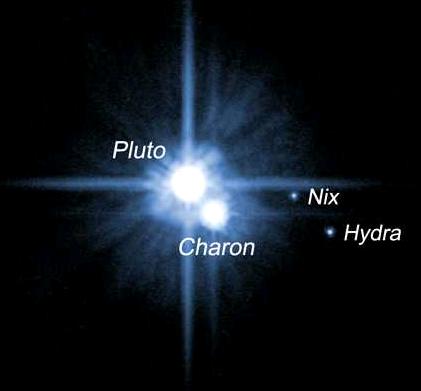
As part of a deliberate search effort for additional moons of Pluto utilizing the Hubble Space Telescope, a team of astronomers led by Alan Stern and Hal Weaver discovered two such objects, since named Nix and Hydra, on May 15, 2005. The same basic team, although now led by Mark Showalter, discovered a fourth moon, now named Kerberos, on June 28, 2011, and a fifth one, now named Styx, on June 26, 2012. All of these objects are relatively small – Nix and Hydra being about 50 km in diameter, and Kerberos and Styx being only 16 to 19 km across – and they all orbit well outside of Charon’s orbit.
The primary tool of our understanding of Pluto and its moons is NASA’s New Horizons mission, which was launched from Cape Canaveral, Florida on January 19, 2006. Following a distant flyby of the main-belt asteroid (132524) APL in June 2006 and a gravity-assist flyby of Jupiter in February 2007, New Horizon flew through the Pluto system on July 14, 2015, passing 12,500 km from Pluto and 28,800 km from Charon. In order that the time of the encounter could be fully devoted to the taking of images and data measurements, the recorded images and data were stored on-board and then transmitted to Earth over the subsequent 15 months.
The New Horizons data showed that Pluto’s surface is primarily made up of nitrogen ice. At least parts of the surface are geologically active – likely due to some form of cryovolcanism – and indeed a large “heart”-shaped feature on the surface that has been named Sputnik Planitia apparently has no impact craters, indicating a young age geologically (i.e., less than ten million years old), with more recent studies indicating an age as low as 180,000 years. Pluto internal structure appears to be differentiated, i.e., with a rocky core and a mantle made of water ice; there may be a subsurface ocean of liquid water perhaps 100 km deep. Charon, meanwhile, also appears to show signs of cryovolcanism, and with the exception of a dark region named Mordor Macula does not exhibit very much in the way of impact craters. Unlike Pluto, Charon does not appear to have much in the way of an atmosphere.

Pluto’s overall small size that has been revealed by scientific studies over the past few decades has forced a rethinking on what should and what should not be considered a “planet.” Pluto, in fact, is in the “trans-Neptunian” region of the solar system where the “Kuiper Belt” originally proposed in the mid-20th Century was believed to exist, and the discovery of other objects in this region of the solar system beginning in 1992 began to bring this discussion up. (The Kuiper Belt as a whole is the subject of a future “Special Topics” presentation.) The first several Kuiper Belt objects that were discovered were relatively small objects on the order of 100 to 200 km in diameter – i.e., significantly smaller than Pluto – and thus for a while there remained a sharp distinction in size between Pluto and these objects. On the other hand, several of these objects have orbital periods roughly the same as that of Pluto, and indeed along with Pluto are in what is called a “2:3 resonance” with Neptune, i.e., they orbit the sun twice for every three orbits that Neptune makes. It is in fact this resonance that makes any collisions with Neptune impossible, even though Pluto does cross within Neptune’s orbit. Resonances like these are discussed in a future “Special Topics” presentation.
Beginning in the early 2000s, however, Kuiper Belt objects approaching the size of Pluto began to be discovered. Matters reached a head in 2005 with the discovery of the Kuiper Belt world now known as Eris, which is just slightly smaller than Pluto in terms of physical diameter but which is somewhat more massive than Pluto. A couple of other Kuiper Belt worlds of similar size were also discovered and/or announced that same year. If Pluto is a “planet,” then these other worlds are “planets” as well, and since there appears to be a gradual continuum in size downward from these, what is and what is not a “planet” devolves into an arbitrary exercise in where to draw the line.
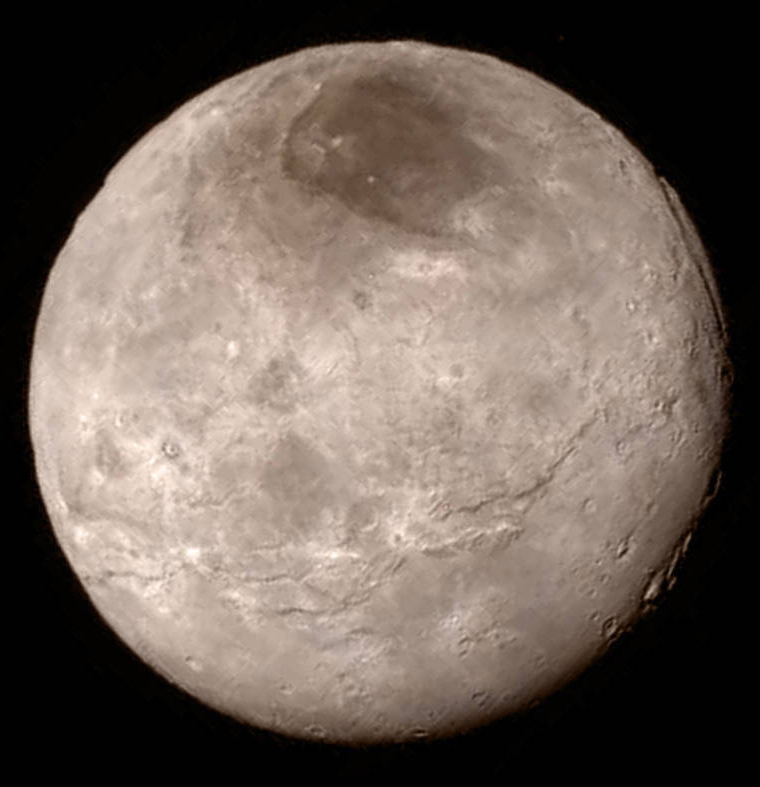
On the concluding day of its General Assembly that was held in Prague, Czech Republic, in August 2006, the remaining attending members of the International Astronomical Union voted for a definition of “planet” that contains the criteria: a) the object is in orbit around the sun; b) the object has enough mass to be in a state of “hydrostatic equilibrium,” or, in other words, has enough mass to be gravitationally forced into a roughly spherical shape; and c) the object has “cleared the neighborhood” around its orbit. By this definition, neither Pluto nor Eris nor any of the other large Kuiper Belt objects are “planets.” Instead, the IAU created a new category of object, called “dwarf planet,” for objects that fulfill the first two criteria, and to date this category includes Pluto, Eris, a handful of other large Kuiper Belt objects, as well as the largest of the “main-belt” asteroids, (1) Ceres. One aftermath of this decision is that Pluto has now been assigned an “asteroidal” number, (134340).
This definition by the IAU has been controversial since then, with some astronomers as well as various members of the general public being opposed to it. Indeed, it can be argued that the criterion of an object “clearing the neighborhood around its orbit” is itself somewhat arbitrary, since if taken to extremes neither Earth nor even Jupiter fulfills it. Nevertheless, the definition remains to this day, and in all honesty, since any definition is going to involve some arbitrariness there perhaps isn’t a better one available.
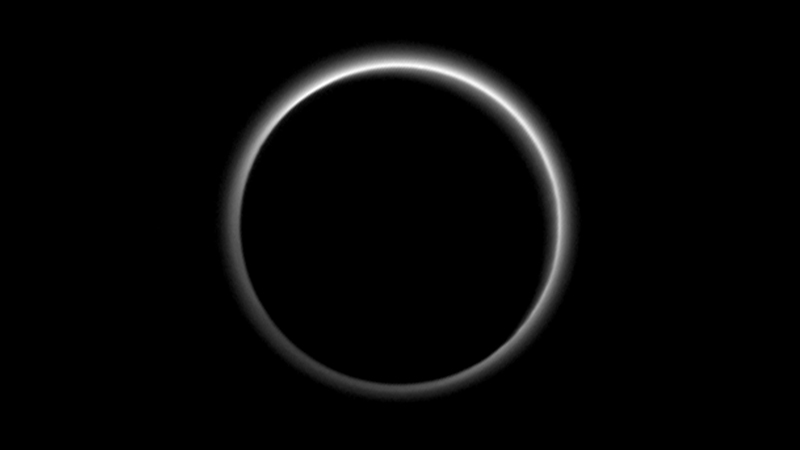
In my own opinion, the term “planet,” as it has been used by humanity ever since the ancient Greeks first used it to describe “wandering stars,” is an outdated concept, as the solar system as we know it today is far more complex than that. For example, Earth and Saturn are both “planets” even though in physical terms they are very dissimilar objects, whereas Titan, which is physically larger than Mercury and is quite similar to Earth in physical terms – to the point of having at atmosphere thicker than Earth’s – is not a “planet.” (The fact that Titan is a moon of Saturn can be argued as being an arbitrary distinction, since both it and Saturn orbit around the system’s center of mass, which itself is what orbits the sun.) Pluto remains a fascinating object regardless of whatever arbitrary label is or is not placed upon it. Finally, there are the thousands of currently known “exoplanets” – with more being discovered all the time – that have been discovered orbiting around other stars (and thus failing the first of the IAU’s “planet” criteria). Many of these worlds appear to have physical characteristics quite unlike anything in our solar system, however, they are large, are presumably spherical, and orbit their respective parent stars just like the “planets” in our solar system orbit the sun.
In that spirit, then, perhaps the best solution is to eschew labels like “planet” altogether, and instead treat each object we discover as a separate world, worthy of recognition and study in its own right.
More from Week 29:
This Week in History Comet of the Week Free PDF Download Glossary
Ice and Stone 2020 Home Page


